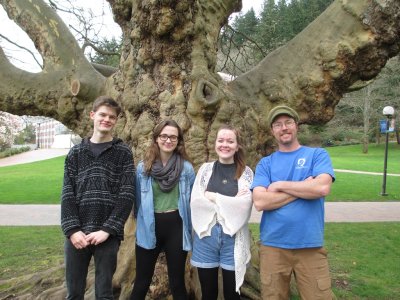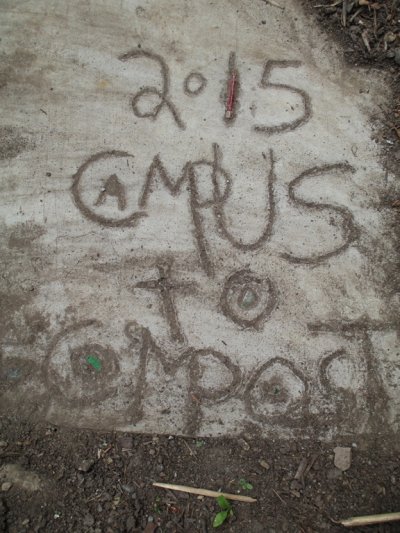New project supplies compost, saves money
The Campus to Compost Green Energy Fee project has begun supplying campus-generated compost to Western Washington University landscaping projects, beginning a closed-loop waste process that will save the university money and reduce its waste stream.
Located at the Facilities Management compost yard, the $4,934 Small Grant project began construction in early spring quarter 2015. A concrete slab was prepared, and two 12-feet-by-9-feet compost bins were constructed out of ecology blocks (large, interlocking, stackable concrete blocks made of leftover concrete).
Grounds Maintenance staff now place all non-invasive yard waste in the bins. To ensure even decomposition of the yard waste, Grounds staff regularly turn the compost pile and cover it with a heavy, black pond liner so it can “cook.”
Once the material has decomposed into a finished product, staff members re-apply the compost to campus grounds. Small yard signs with the project name and Green Energy Fee logo are placed at each application site to bring attention to the project. This continued process will create a long-term, sustainable source of compost for Western’s landscaping projects.
Previously, Western paid thousands of dollars to ship its yard waste to Skagit County, where it was processed and re-sold by a private company. Western would then have to buy compost back for it grounds operations, spending even more money.
After witnessing this process firsthand, student gardeners Alicia Terry, Darcy Ruppert, Julian Frawley and Grounds Maintenance staff member Luke Mason came up with the idea of using campus-generated compost onsite.
“I knew something had to be done to create a place to compost our material onsite,” said Mason. “I was notified of the Green Energy Fee program by Campus Sustainability Manager Seth Vidana, and he suggested I apply.”
Mason and his student team then worked with the Green Energy Fee Grant Program Coordinator Nate White to plan the project and apply for funding.
“This project is a great example of using Green Energy Fee funds to kickstart sustainable practices at Western,” White said. “Although this is a Small Grant project, it will have a large impact in reducing Western’s yard waste.”
With the Campus to Compost project now operational, it is expected to retain 100 cubic yards of compostable material per year, saving an estimated $3,500 per year. Generating and reusing compost on campus will also lower transportation emissions by reducing the amount of heavy trucks on the road to dispose of campus yard waste.
“We have already generated over 22 yards of compost, and some of this compost has already been applied to Fairhaven and Buchanan Towers,” Mason said. “We look forward to the continued efforts of the hard working grounds crew to generate and apply this awesome material.”
About the Green Energy Fee
The student-funded Green Energy Fee was established in 2005 through a student vote to purchase 100-percent renewable energy for Western. In 2010, the GEF was re-authorized by students to continue buying 100-percent renewable energy and to create a $300,000 grant program to fund sustainability projects on campus.
This year, students again re-authorized the fee, which will be known as the Sustainable Action Fund beginning fall quarter, 2015. The program is managed by the Office of Sustainability with oversight by the Associated Students and a committee made up of students, faculty and staff.
The next round of grant applications will be accepted during fall quarter, 2015. Check the Apply page of the GEF website at the beginning of fall quarter for application deadlines.

